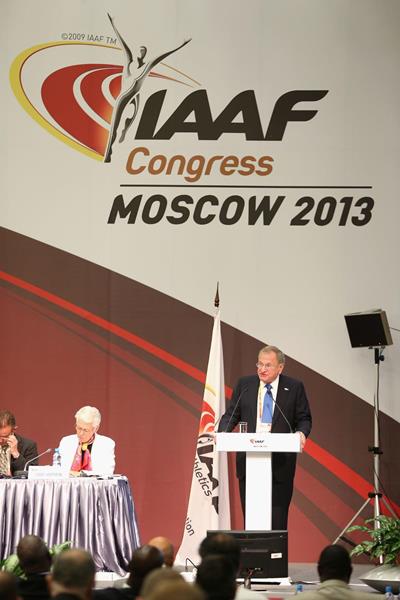Moscow – Russia, Aug 07, 2013: Ahead of the IAAF World Championships in Moscow, the first day of the 49th IAAF Congress played host to the 1st IAAF World Athletics Forum, providing an environment for lively and open debate among Congress delegates about the future of athletics.jresident Lamine Diack and welcomed seven speakers and 17 panellists, each from a different country, as they provided expert and diverse perspectives and insights from both inside and outside the athletics family.
The first keynote address was delivered by Soichi Takahashi, general manager of international sports at Dentsu. He spoke about the current environment for sports in general, looking at where athletics stands in relation to other sports in terms of audience and viewership. Takahashi also touched upon the most popular platforms in sport as well as the major marketing and consumer trends.
Following that, IAAF General Secretary Essar Gabriel outlined the vision, missions and objectives of the 2013-2016 IAAF Strategic Plan, which picks up the baton from the IAAF Athletics’ World Plan – a ten-year strategy to propel the sport forward, which concluded in December last year.
The IAAF Strategic Plan comprises three phases – strategic and organisational review, strategic plan, and action plan – and it begins with the six IAAF core values: universality, leadership, unity, excellence, integrity and solidarity.
The next two years will be the kick-off phase of the IAAF Strategic Plan. There are 33 sub-objectives, of which 15 are new and 18 are on-going, with 79 milestones to chart the progress of the Plan.
IAAF Senior Vice President Robert Hersh outlined some of the latest evolutions for future IAAF competitions, of which one of the most significant was the new qualification system for the Olympic Games and World Championships.
Effective for the 2015 IAAF World Championships in Beijing, there will be a fixed number of athletes per event with the combined total of 2000 athletes competing. Instead of ‘A’ and ‘B’ standards, there will be a single qualification standard for each event, which aims to fill 75% of the quota for that discipline. The rest of the places will be filled by the top-ranked athletes in each event.
All other existing qualification elements – such as the three athletes per nation rule and wildcard entries – will remain generally unchanged. In future this qualification format may be extended to youth and junior championships.
Another development Hersh outlined was the inclusion of an 8x100m relay at the Youth Olympic Games. Held in a public venue outside of the stadium, it will involve all athletes at the event – not just sprinters, but throwers, jumpers and distance runners too. The team selection will be random and they will decide the running order among themselves.
Pere Miro, director of Olympic solidarity, gave an update on the current IOC Olympic solidarity programme, and he was followed by Timothy Armstrong from the World Health Organisation who explained ways in which people within athletics can make the world a healthier place.
There were three breakout sessions in the afternoon, each of them featuring IAAF Council members and respected athletes.
The first, which was on the subject of promotion and development of athletics, saw former Marathon World record-holder Tegla Loroupe talk about her own experiences and how she has made positive changes in her home country of Kenya through the Tegla Loroupe Peace Foundation.
“When I competed, my thought was always, ‘what can I do to help athletes from my area?’ I knew there were so many other athletes who were better than me but had never had the opportunity to train or compete,” she said.
“I had lots of offers to compete for other countries, but I turned them down. I don’t run away from problems. I wanted to run for my country to empower women and put something back. But running isn’t the only way to get us to another level; education is important too.”
The second breakout session, on the subject of ethics in athletics, was chaired by IAAF Vice President Sebastian Coe. In it, Marathon World record-holder Paula Radcliffe spoke about the risks of corruption in athletics; mainly with regards to doping, but also illegal betting and age manipulation.
“What we underpinned was that we need to work a lot more on the ethics and morals of young athletes and increase the level of sanctions so the risks outweigh the benefits for potential cheats,” said Radcliffe.
“In some cases, young athletes are actually being abused, if they’re being forced to believe they have no other option but to dope. In those cases, the abusers should be sanctioned.
“We need to work on the moral and ethical standpoint where athletes stand tall and are proud of what they’ve achieved because they’ve done it fairly. It’s the core, the future and marketability of the sport.”
IAAF governance was the theme of the third breakout session. Chaired by IAAF Council member Abby Hoffman, 1993 World 200m champion and IAAF Council member Frank Fredericks outlined ways in which the IAAF can evolve through consulting with athletes.
“As chairman of the IAAF Athletes Commission, I want to make sure that the voice of the athlete is taken seriously,” said Fredericks. “It’s very important that athletes know their voices are being heard.
“We want to be able to say what athletes on the ground want what they feel and what they want changed. Ideally every member federation should have its own athlete’s commission. That way, if there are problems in any country, I want to be able to discuss them directly with the athletes.”
Hoffman, twice an Olympic 800m finalist for Canada, perhaps summed the day up best.
“We had a terrific level of engagement in our forum; if anything, it ended too soon,” she said. “I really hope we’ll do it again because there was a lot of demand for people to participate in meaningful discussion.” —- IAAF/Photo: Getty Images



Leave a Reply
You must be logged in to post a comment.